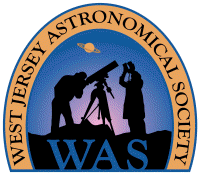| Weather Links |
Mercury 2023
|
Young Moon
at Barnegat
May 21, 2023
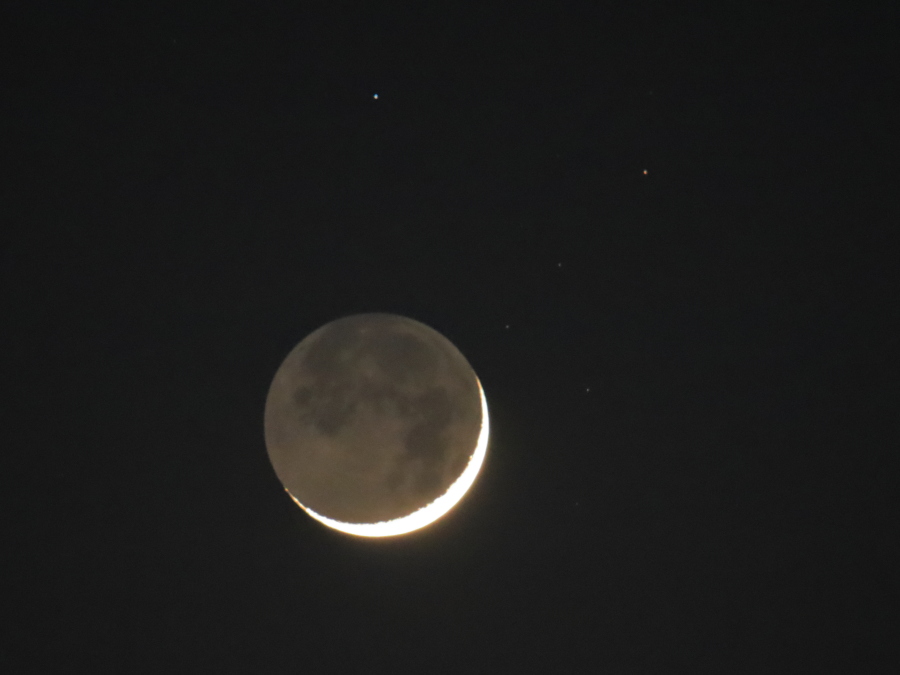
|
Here's the young crescent
Moon (about 2.4
days old) on
May 21, 2023, at 9:30 pm EDT, as seen through a
veil of smoke that had wafted over New Jersey from forest fires
in Canada. As a result, the earthshine was muted, and later on,
the stars were dull and no Milky Way was visible in the Summer
Triangle.
Taken from the WAS's Barnegat Rd Observing Site in the NJ Pines with a Canon EOS RP DSLM
and a Tamron 150 to 600 mm f/5.0-6.3 zoom lens (on a fixed
tripod) set to 600 mm focal length. It's a single raw frame
exposed 1.3 seconds at f/6.3, ISO 12,800. The raw image was
lightly adjusted and cropped to about 60% of the original dimensions
(to a 4:3 ratio) for a field 2.0° wide x 1.5° high, then converted to a JPEG in
Canon's Digital Photo Professional 4.
At the time, the Moon was at 10.7° altitude, 297° azimuth. The star directly above the Moon is 136 Tau, mag 4.6, B-V = 0,
and the star to it's right, and down slightly, is HD 39004, mag
5.6, B-V = 1.0 (so it has a ruddy tinge). The triangle of stars
immediately right of the Moon are nominally 7th magnitude. |
Rising Moon
near Horizon
May 9, 2023
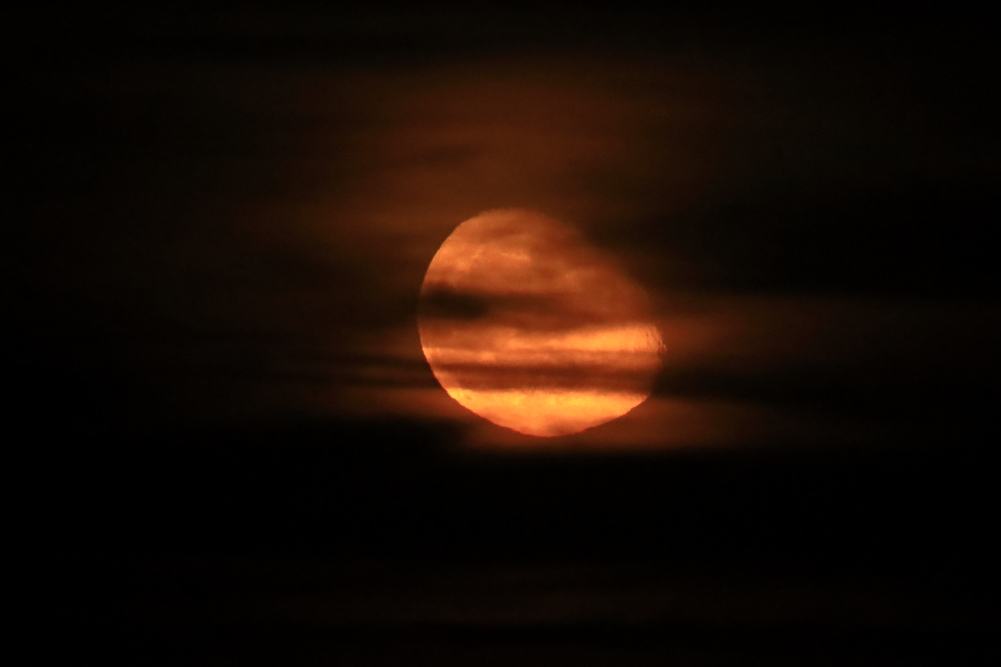
|
Here's the 85% illuminated gibbous
Moon on
May 9, 2023, at 12:08 am EDT, about 3½ days
after Full Moon on May 5 at 1:34 pm EDT,
through clouds 17 minutes after rising at 11:51 pm on May 8 when
it was just 2.0° altitude (including atmospheric
refraction), hence the orange coloration. Taken
from Marter Ave in Mt Laurel, NJ, with a Canon EOS RP DSLM and a Tamron 150 to 600 mm f/5.0-6.3
zoom lens (on a fixed tripod) set to 600 mm focal length. It's a
single raw frame exposed 1/30 second at f/8.0 (spot metered,
auto minus 1 stop in camera), ISO 6400,
daylight white balance. The raw image was
not subsequently adjusted, except for cropping to 58% of the original dimensions
for a field 2.0° wide x 1.3° high, then converted to a JPEG in
Canon's Digital Photo Professional 4. |
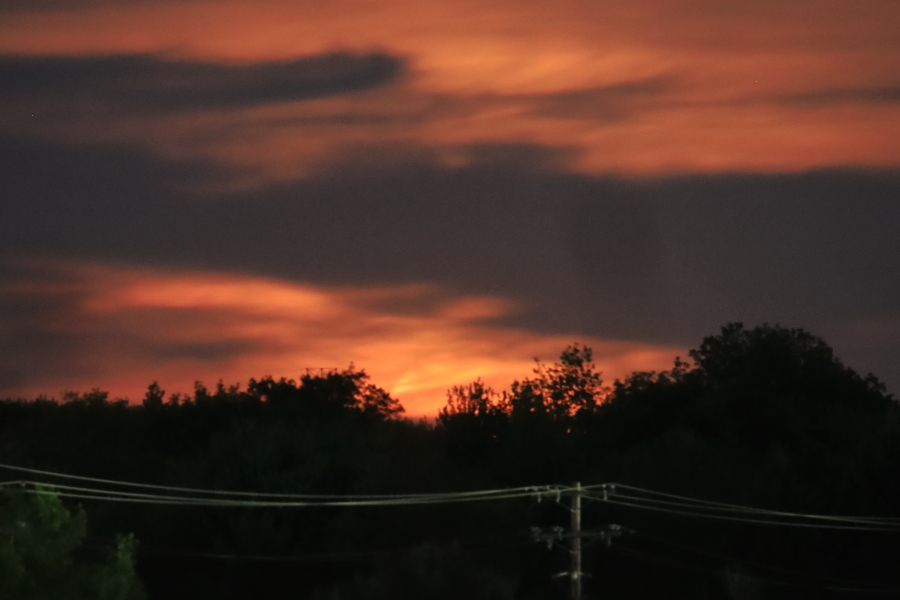
|
Here's the initial view of the
Moon on
May 8, 2023, at 11:56 pm EDT, through clouds 5
minutes after rising at 11:51 pm when
it was
just 0.6° altitude (including atmospheric
refraction) with orange coloration despite auto white balance.
Taken from Marter Ave in Mt Laurel, NJ, with a Canon EOS RP DSLM
and a Tamron 150 to 600 mm f/5.0-6.3 zoom lens (on a fixed
tripod) set to 600 mm focal length. It's a single raw frame
exposed 8 seconds at f/8.0 (spot metered, auto), ISO 6400, which
is 7.9 additional stops of exposure (240x) vs. the previous
image. The raw image was slightly adjusted (brightness reduced
by half a stop) and cropped to 58% of the original dimensions
for a field 2.0° wide x 1.3° high, then converted to a JPEG in
Canon's Digital Photo Professional 4. |
Rainbow,
Segment of Arc
May 5, 2023
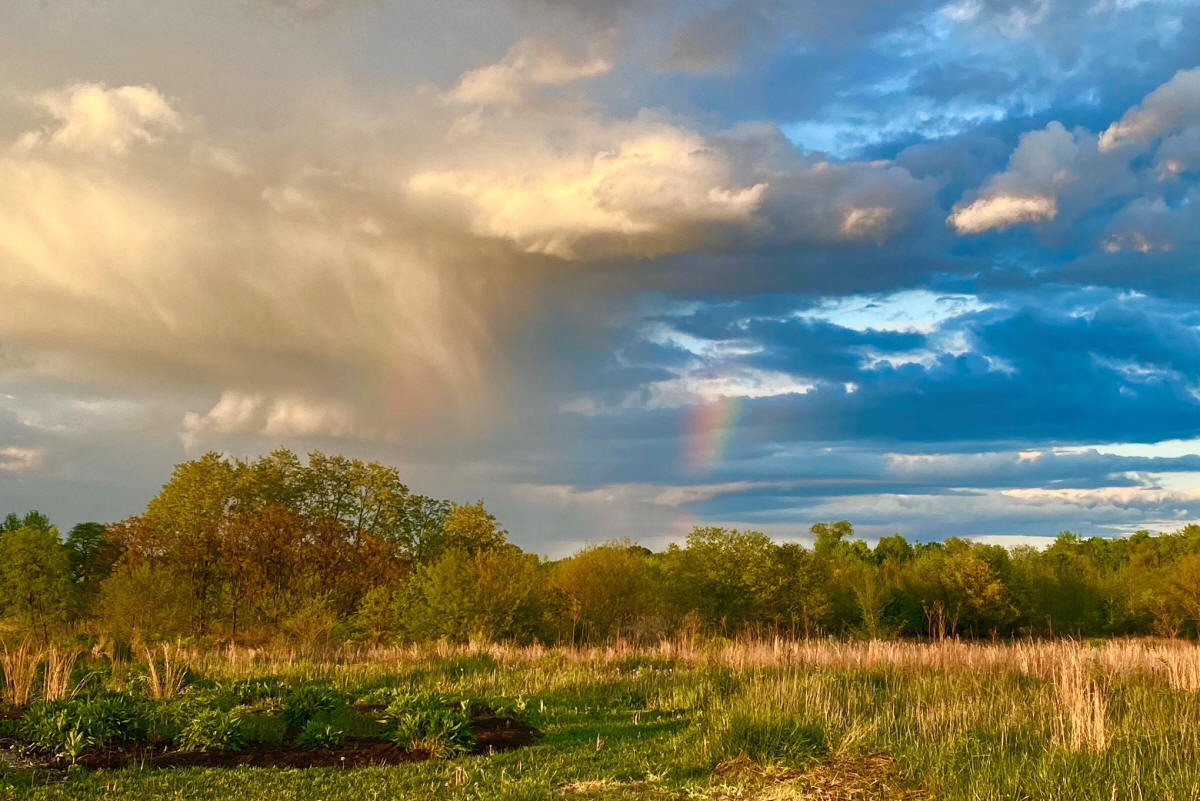
|
On the way to the
WAS
meeting on
May 5, 2023, I was driving down Westfield Rd in
Moorestown, NJ, when a short rainbow on my left (nominally
towards the southeast), so I pulled into the Swede Run parking
lot and took a few snapshots with my iPhone 11. The picture
above was taken at 7:29 pm EDT and the one below at 7:30 pm
(sunset would be at 7:58 pm). Both were taken at 26 mm
equivalent focal length (4.25 mm actual), f/1.8, ISO 32 and
exposed 1/500 second. They were mildly adjusted and cropped with
the photo editor of my iPad. There is an obvious short rainbow
segment just above the trees at the horizontal midpoint of each,
and on the upper photo, there's also a very vague segment of a
double rainbow in the whitish cloud roughly midway between
center and the left edge of the frame. The double bow was better
seen seen with with unaided eyes, but didn't last that long.
About 10 minutes later in the parking lot on the way into the
meeting, the bright rainbow segment colors were quite intense,
including violet. |
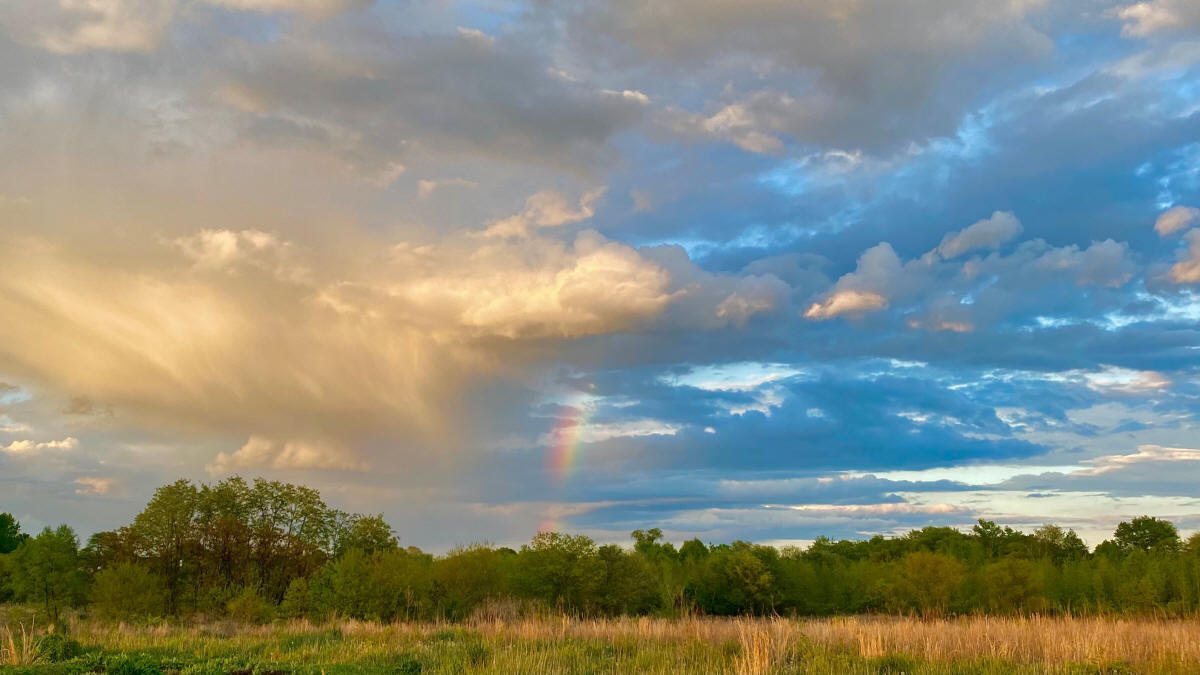
Venus and the
Crescent Moon
April 23, 2023
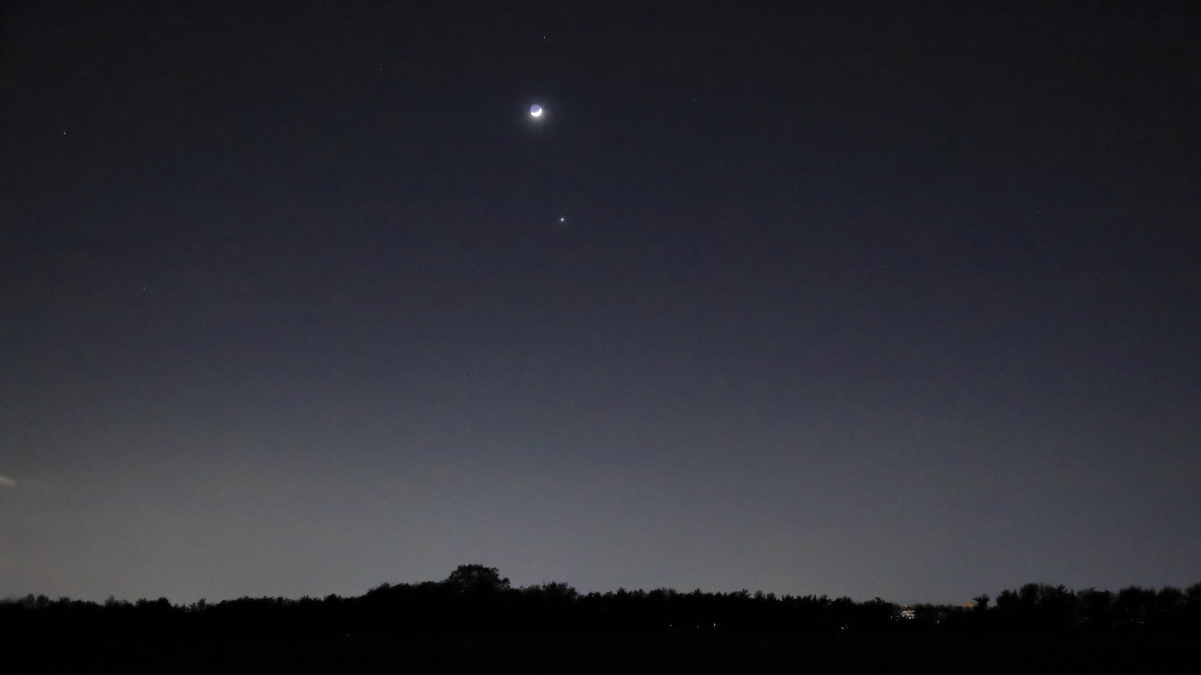
|
The inner planet Venus
and the Crescent Moon were
close together on
April 23, 2023, when this snapshot of them
was captured at at 9:18 pm EDT
from Bishops Gate in Mt Laurel, NJ, with a Canon EOS RP DSLM camera and a
Canon 24-105 mm f/4.0L zoom lens, set to 35 mm focal length, on
a fixed tripod. It's a single raw frame exposed
1/13 second at f/4.0, ISO 12,800. The raw image was
mildly adjusted, cropped to 99% x 845 of the original dimensions
(16:9 ratio) for a field
35° wide x 20° high, then converted to a JPEG in
Canon's Digital Photo Professional 4. Mouseover for labels.
At the time, Venus (69% illuminated) and the Moon (16%
illuminated) were about 5.2° apart. |
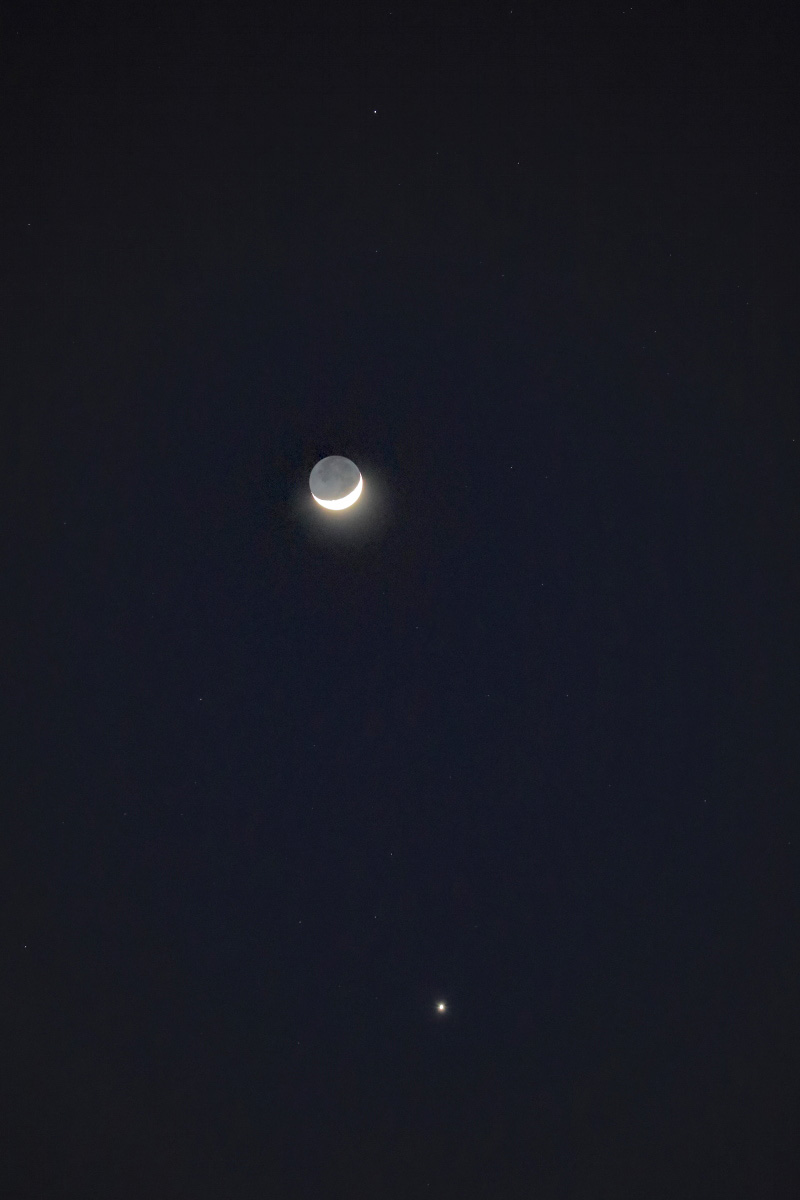
|
Here's a closer view of the planet
Venus, the
Crescent Moon
and the star
Elnath
(Beta Tauri) on
April 23, 2023, at 8:43 pm EDT.
Taken with a Canon EOS RP DSLM and a Tamron 150 to 600 mm
f/5.0-6.3 zoom lens (on a fixed tripod) set to 150 mm focal
length. It's a single raw frame exposed 1/6 second at f/1.4, ISO
12,800. The raw image was mildly adjusted, cropped to 87% of the
original dimensions for a field 7.9° wide x 11.8° high, and converted to a JPEG in
Canon's Digital Photo Professional 4, then mildly adjusted with
Adobe Photoshop Elements. Mouseover for labels.
Since it was taken about half-an-hour before the picture above,
Venus and the Moon are about a quarter-degree closer together. |
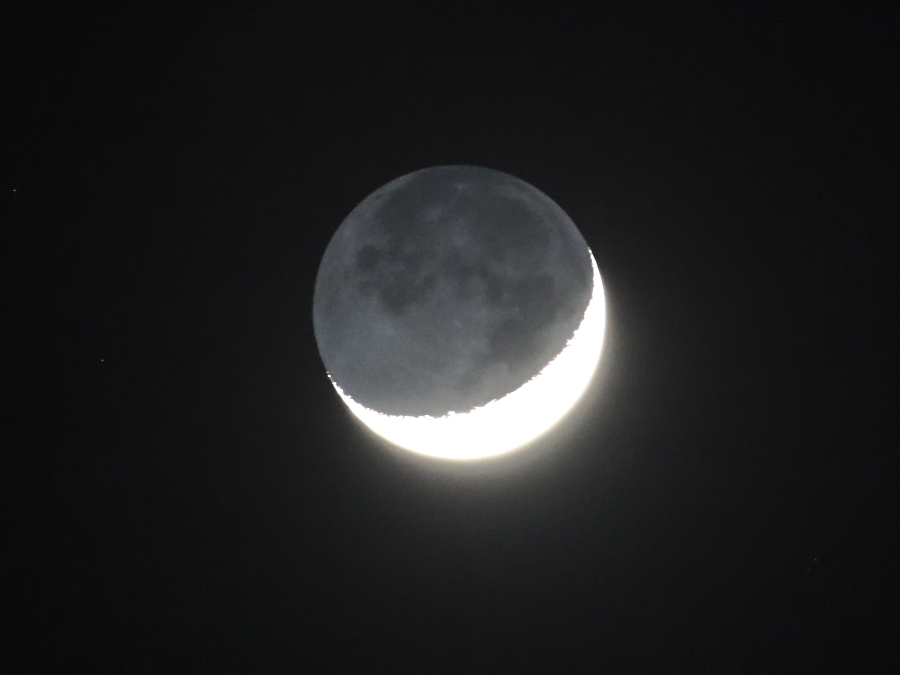
|
Finally, here's an even closer view of the
Crescent Moon,
with earthshine, on
April 23, 2023, at 8:46 pm EDT. Taken
with a Canon EOS RP DSLM and a Tamron 150 to 600 mm f/5.0-6.3
zoom lens (on a fixed tripod) set to 600 mm focal length. It's a
single raw frame exposed 1/8 second at f/6.3, ISO 12,800. The raw image was
mildly adjusted, cropped to 45% x 50% of the original dimensions
(a 4:3 ratio) for a field 1.5° wide x 1.2° high, then converted to a JPEG in
Canon's Digital Photo Professional 4. To show the earthshine,
the sun-illuminated crescent is greatly overexposed. |
Venus and Mercury
April 9, 2023
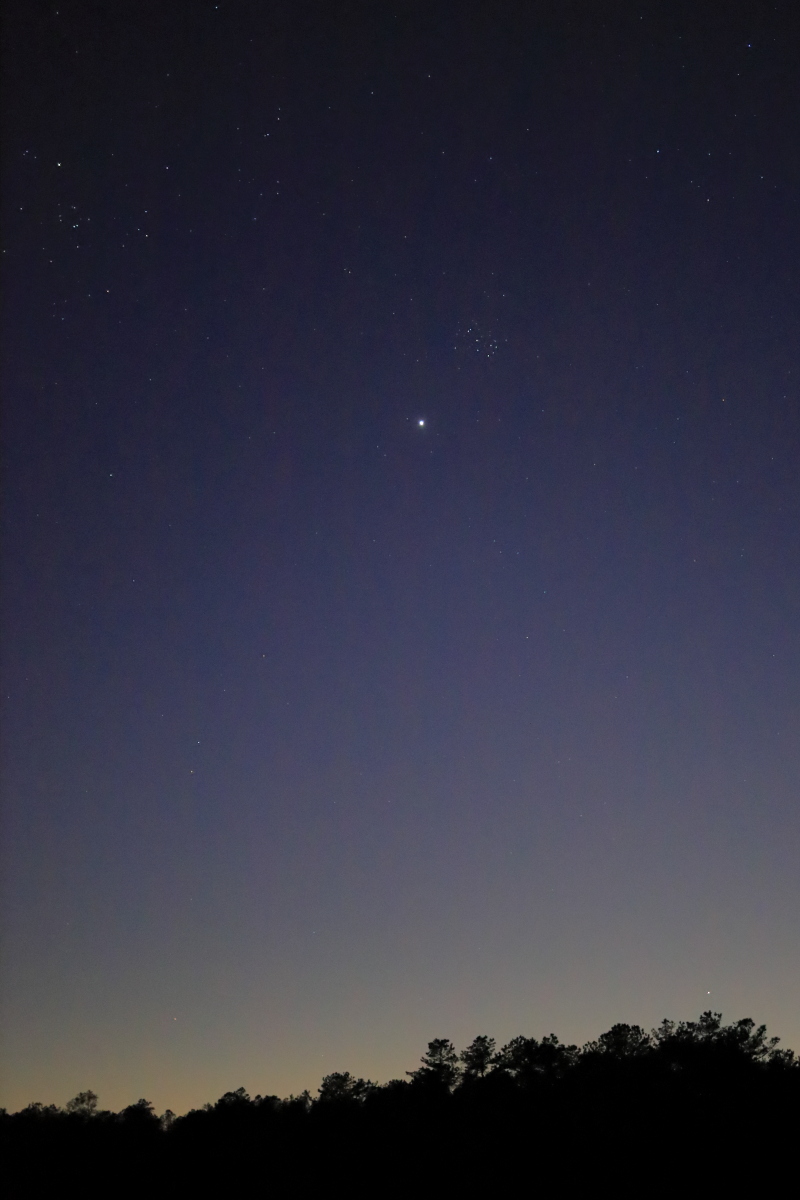
|
On
April 9, 2023, the brilliant planet
Venus
was 3.1° from the Pleiades star cluster (M45) in the
constellation
Taurus. For southern New Jersey, a minimum spacing of 2.6°
will occur on the evenings of April 10 & 11 (however, Venus
is within the Pleiades at eight-year intervals,
most recently
in 2020). The planet
Mercury
is also visible now after sunset, one of its best elongations of
2023. In between is the dim planet
Uranus. All three
are present in this image captured at at 8:37 pm
EDT from Wharton State Forest, NJ, with a Canon EOS RP DSLM camera and a
Sigma 50 mm, f/1.4 Art lens
(on a fixed tripod). It's a single raw frame exposed 1/13 second at f/1.4, ISO 12,800
and daylight white balance. The raw image was
mildly adjusted, cropped to 90% of the original dimensions for a field
24° wide x 36° high, then converted to a JPEG in
Canon's Digital Photo Professional 4. Mouseover for labels. |
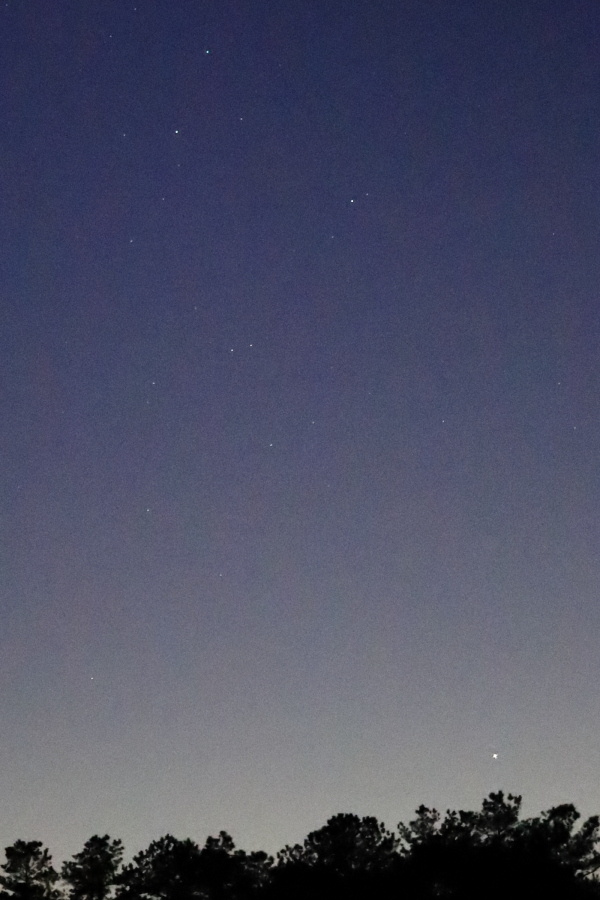
|
Same as above image, but cropped and processed to enhance
Uranus
and the stars around it. It is 38% of the original frame
for a field 10.5° wide x 15.7° high. Mouseover for labels. |
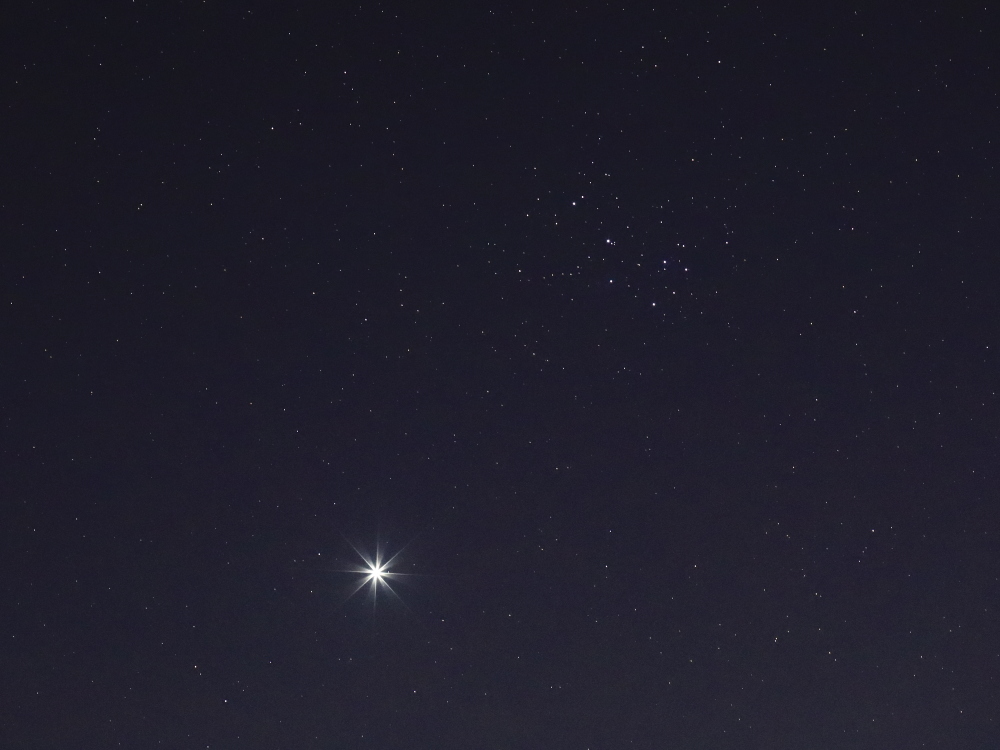
|
Here's a closer view of Venus
and the Pleiades on
April 9, 2023. This image was captured at at 8:47 pm
EDT from Wharton State Forest, NJ, with a Canon EOS RP DSLM camera and a
Canon 200 mm, f/2.8L lens
(on a fixed tripod). It's a single raw frame exposed 1.6 seconds at f/4.0, ISO 12,800
and daylight white balance. The raw image was
mildly adjusted, cropped to 72% x 81% of the original dimensions
(to a 4:3 ratio) for a field 7.4° wide x 5.6° high, then converted to a JPEG in
Canon's Digital Photo Professional 4. Mouseover for labels.
Note: The eight spikes radiating from brilliant and
unavoidably overexposed Venus are the result of
diffraction from the eight diaphragm blades in the 200 mm
f/2.8L lens. |
Venus and Uranus
March 30, 2023
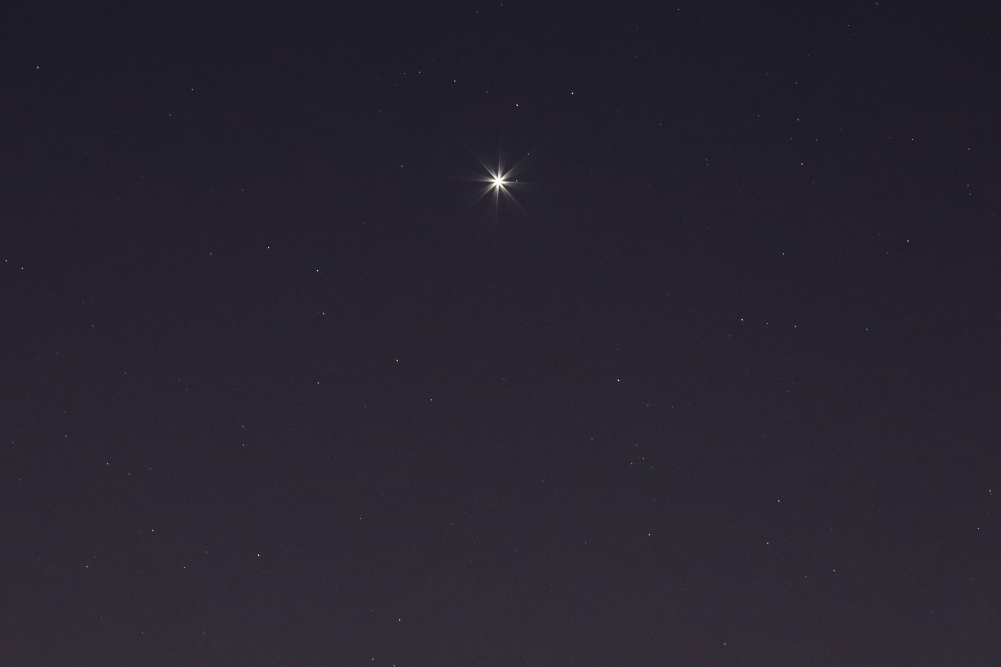
|
On
March 30, 2023, the brilliant nearby planet
Venus
passed (apparently) by the distant and dim planet
Uranus
in the evening sky before they set around 10:30 pm EDT. They
would reach conjunction in geocentric right ascension about 5 hr
later on March 31 at 2 am. This snapshot of the pair
was captured at at 8:40 pm
from Mt Laurel, NJ, with a Canon EOS RP DSLM camera and a
Canon 200 mm, f/2.8L lens
(on a fixed tripod). It's a single raw frame exposed 2 seconds at f/4, ISO 1600
and daylight white balance. The raw image was
mildly adjusted, cropped to 58% of the original dimensions for a field
5.9° wide x 4.0° high, then converted to a JPEG in
Canon's Digital Photo Professional 4. Mouseover for labels.
At the time, the two planets were 1.2° apart. Venus blazed at
magnitude -4.0 while Uranus was a binocular object at magnitude
+5.8 in the suburban sky with a 68% illuminated Moon overhead.
That's a difference of 9.8 magnitudes, or 8,300x the brightness.
The mouseover triangle marks an impromptu asterism I've been
using in recent days to pinpoint Uranus. Again, the spikes radiating from
Venus are due to
diffraction. |
Jupiter and Mercury
March 26, 2023
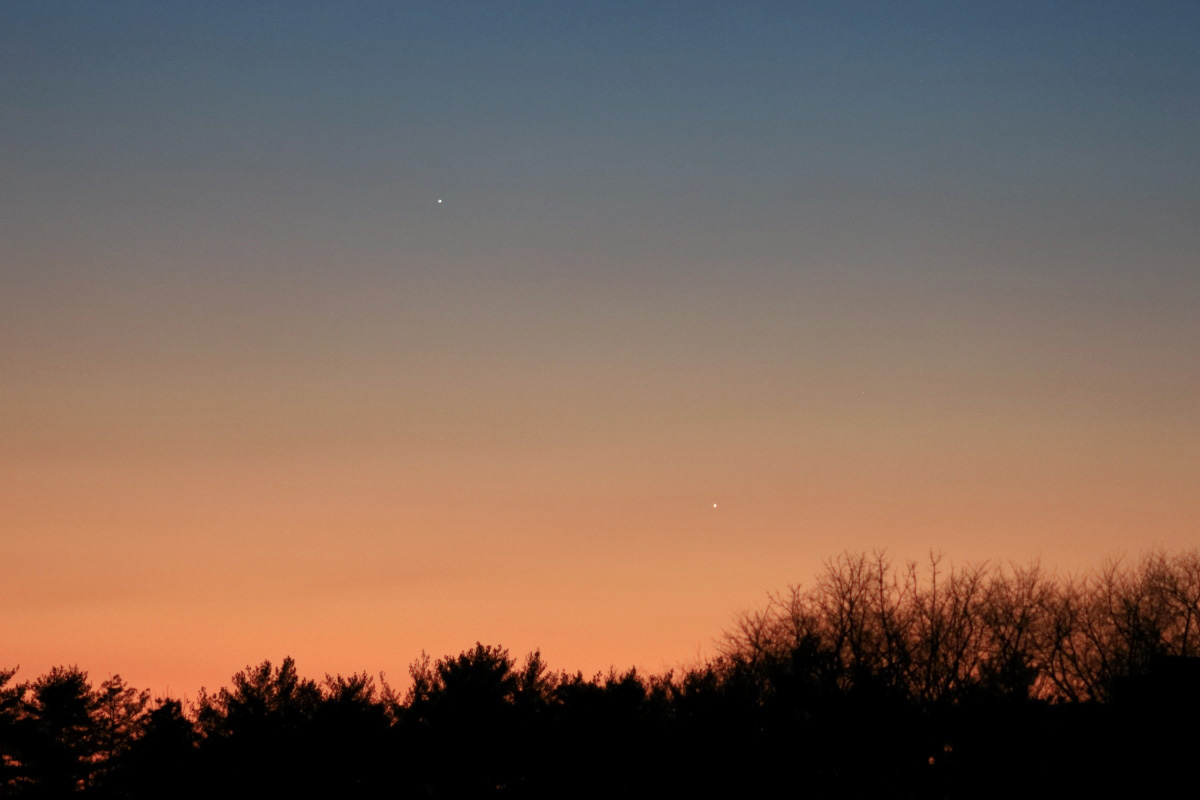
|
Jupiter
and Mercury were
close together on
March 26, 2023, when this snapshot of the pair
was captured at at 7:47 pm EDT
from Mt Laurel, NJ, with a Canon EOS RP DSLM camera and a
200 mm, f/2.8L lens
(on a fixed tripod). It's a single raw frame exposed
1/200 second at f/2.8, ISO 1600
and daylight white balance. The raw image was
mildly adjusted, cropped to 67% of the original dimensions for a field
6.9° wide x 4.6° high, then converted to a JPEG in
Canon's Digital Photo Professional 4. Mouseover for labels.
At the time, the two planets were about 2.5° apart. Magnitude
-2.1 Jupiter was at 5.0° altitude, magnitude -1.4 Mercury 3.2°
altitude and both both were nominally due west at 275° azimuth.
Jupiter is now sinking towards the sun at sunset and solar conjunction
is on April 11. Mercury
is moving eastward after superior conjunction on March 17 and
will reach greatest eastern elongation on April 11. Of course, all three bodies are
actually moving eastward with respect
to the celestial sphere. Venus more quickly the sun, so its
solar elongation is increasing, while Jupiter is moving more
slowly than the sun, so its solar elongation is decreasing. |
The Crescent Moon and Jupiter
March 22, 2023
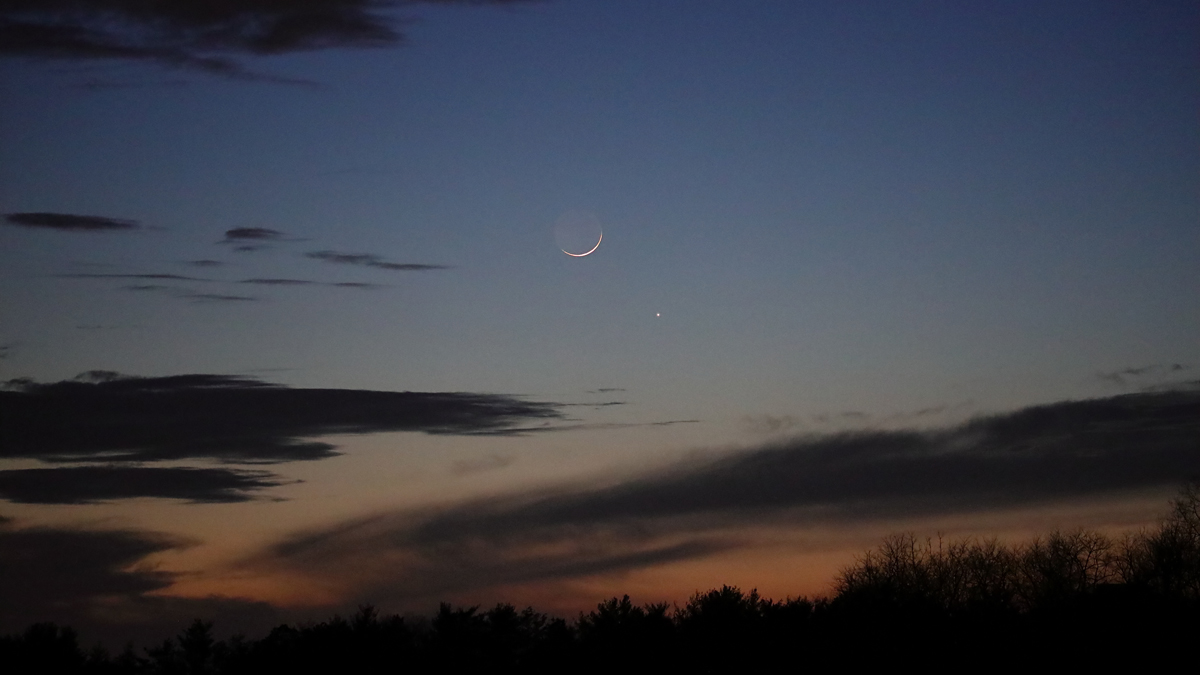
|
The thin
Crescent Moon,
about 31 hours old and 2.0% illuminated, was close to the planet Jupiter on
March 22, 2023. This snapshot of the pair was
captured at at 7:56 pm EDT
from Mt Laurel, NJ, with a Canon EOS RP DSLM camera and a
Tamron 150 to 600 mm, f/5.0 to
f/6.3 zoom lens
(on a fixed tripod) set to 150 mm focal length.
It's a single raw frame exposed 1/40 second at f/5.0, ISO 12,800
and daylight balance. The raw image was
slightly adjusted, cropped vertically to a 16:9 ratio for a field
about 13.6° wide x 7.7° high, then converted to a JPEG in
Canon's Digital Photo Professional 4. Final touch-up and
re-sizing done with Adobe Photoshop Elements.
At the time, the two objects were about 1.32° apart center-to
center (1.04° limb-to-limb) with Jupiter below-right of the
Moon. The Moon was about 6.3° altitude and Jupiter 5.3°
altitude, both nominally 273° azimuth, essentially due west.
2.0% of the Moon
(the crescent)
is directly illuminated by the
Sun, the remainder of the disc is ashen-gray from
Earthshine, sunlight reflected by the nearly-full
Earth as it would appear to an observer on the Moon. |
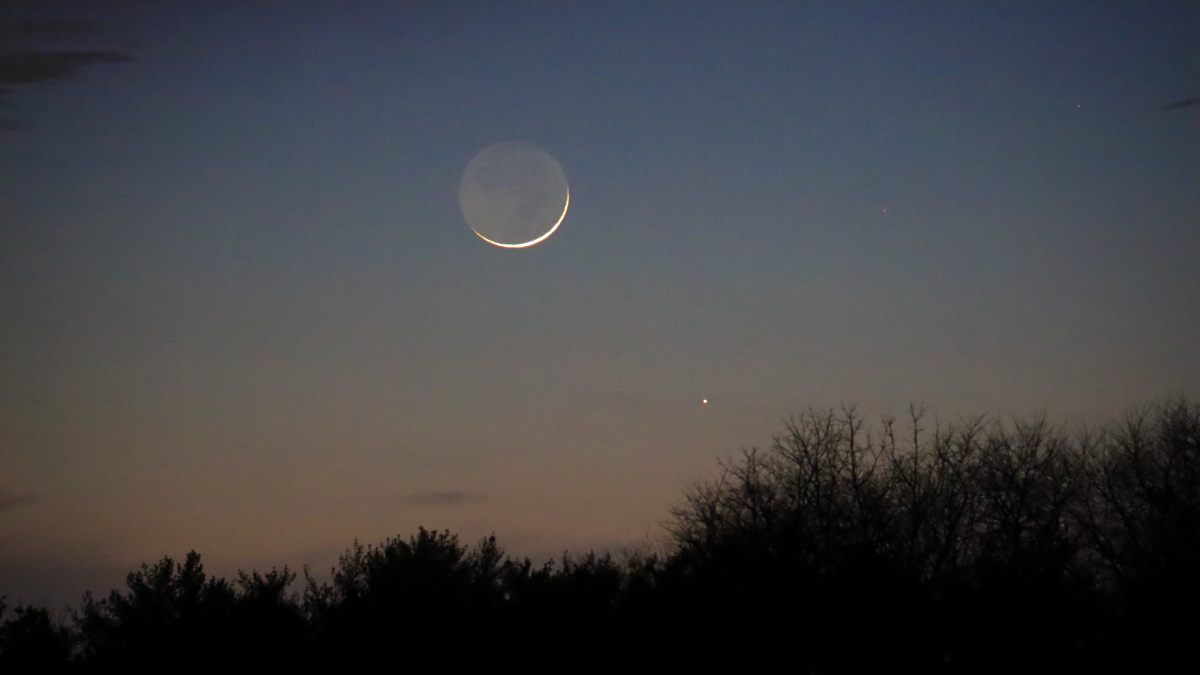
|
Here's the pair at 8:09 pm EDT on
March 22, 2023, taken with the same camera and
lens, but set to 329 mm focal length. It's a single raw
frame exposed 1/8 second at f/5.6, ISO 12,800 and daylight white balance. The raw image was
slightly adjusted, cropped vertically to a 16:9 ratio for a field
about 6.3° wide x 3.5° high, then converted to a JPEG in
Canon's Digital Photo Professional 4.
At the time, the two objects were about 1.43° apart center-to
center (1.16° limb-to-limb). The Moon was about 4.0° altitude and Jupiter
was at 2.9°
altitude, both nominally 275° azimuth, essentially due west. The
faint star in the upper-right corner of the frame is magnitude
4.3 Epsilon Piscium. |
Venus and Jupiter
March 5, 2023
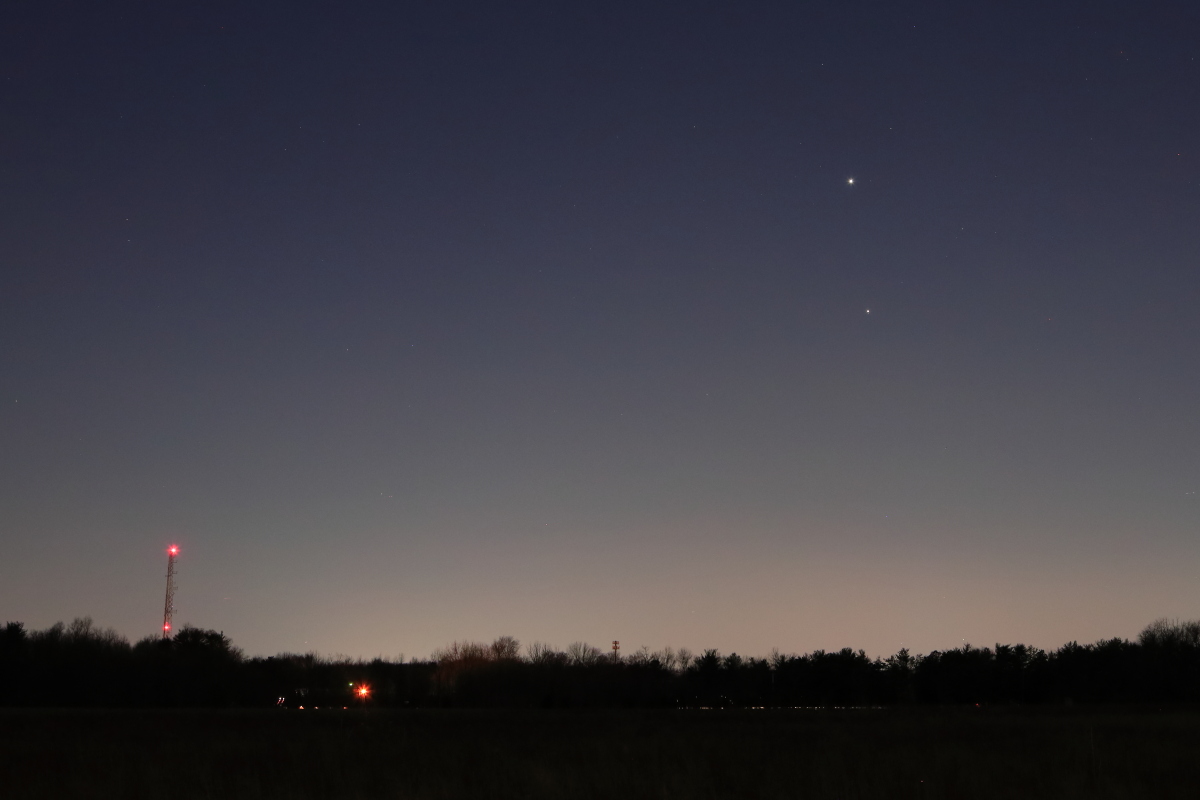
|
The two brightest planets,
Venus
and Jupiter,
were captured in this snapshot taken on
March 5, 2023,
at 7:10 pm EST
from Mt Laurel, NJ, with a Canon EOS RP DSLM camera (on a
fixed tripod) and a Canon 24 to 120 mm
f/4.0L zoom lens set to 47 mm focal length. It's a single raw frame
exposed 0.6 seconds at f/5.6, ISO 1600 and auto white balance. The raw image was
slightly adjusted, cropped to 77% of the original linear dimensions for a field
about 33° wide x 22° high, then converted to a JPEG in
Canon's Digital Photo Professional 4.
Mouseover for labels.
At the time, the two planets were about 3.8° apart, following
their appulse just half a degree apart on March 1, 2023, which
for several reasons including poor weather, I was not able to
observe. Also at the time, Venus was at 15.3° altitude and Jupiter
was at 11.4°
altitude, both nominally 265° azimuth, just shy of due west at 270°
azimuth. |
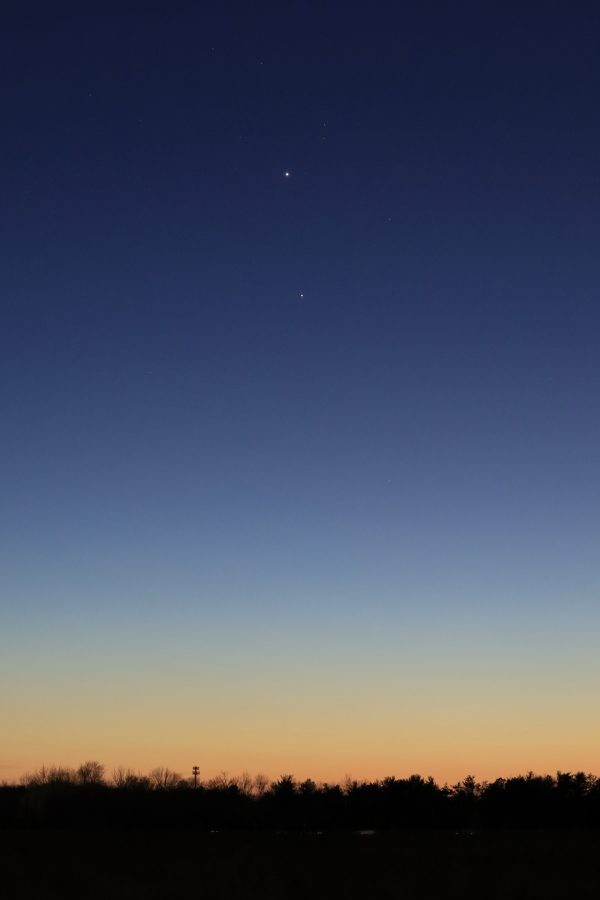
|
Here's an earlier shot of
Venus
and Jupiter,
captured on
March 5, 2023,
at 6:44 pm EST
from the same Mt Laurel, NJ, location. Taken with the
same Canon EOS RP DSLM camera (on a fixed tripod), but using a
Sigma 50 mm f/1.4 Art lens. It's a single raw frame
exposed 0.3 seconds at f/2.8, ISO 1600 and daylight white
balance. The raw image was
slightly adjusted, cropped to 67% of the original linear dimensions for a field
about 18° wide x 27° high, then converted to a JPEG in
Canon's Digital Photo Professional 4.
Mouseover for labels.
The separation was essentially the same, but Venus was at 20.3°
altitude and Jupiter was at 16.5°
altitude, both nominally 261° azimuth. |
Click here
for the previous page.
Click here
for an index to all previous SJAstro pages.

















